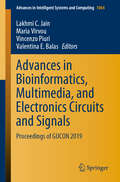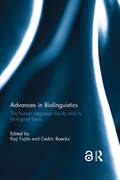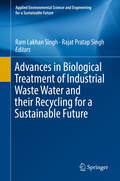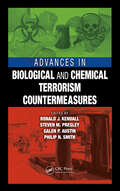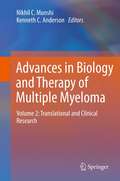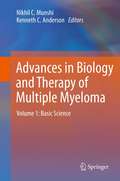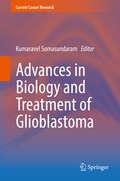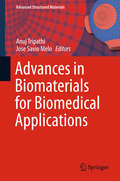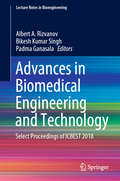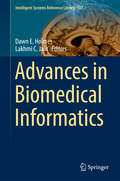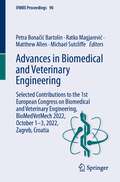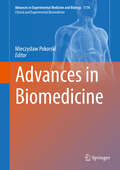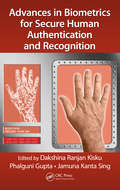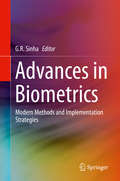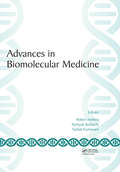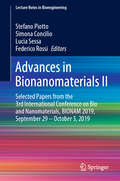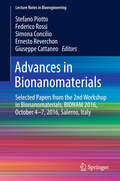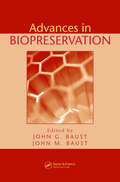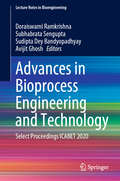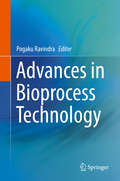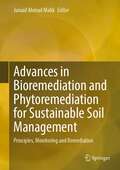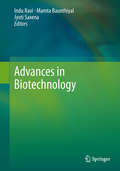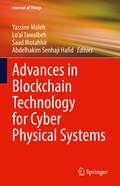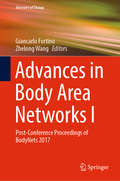- Table View
- List View
Advances in Bioinformatics, Multimedia, and Electronics Circuits and Signals: Proceedings of GUCON 2019 (Advances in Intelligent Systems and Computing #1064)
by Lakhmi C. Jain Vincenzo Piuri Maria Virvou Valentina E. BalasThe book features selected high-quality papers presented in International Conference on Computing, Power and Communication Technologies 2019 (GUCON 2019), organized by Galgotias University, India, in September 2019. Discussing in detail topics related to electronics devices, circuits and systems; signal processing; and bioinformatics, multimedia and machine learning, the papers in this book provide interesting reading for researchers, engineers, and students.
Advances in Biolinguistics: The Human Language Faculty and Its Biological Basis
by Koji Fujita and Cedric BoeckxBiolinguistics is a highly interdisciplinary field that seeks the rapprochement between linguistics and biology. Linking theoretical linguistics, theoretical biology, genetics, neuroscience and cognitive psychology, this book offers a collection of chapters situating the enterprise conceptually, highlighting both the promises and challenges of the field, and chapters focusing on the challenges and prospects of taking interdisciplinarity seriously. It provides concrete illustrations of some of the cutting-edge research in biolinguistics and piques the interest of undergraduate students looking for a field to major in and inspires graduate students on possible research directions. It is also meant to show to specialists in adjacent fields how a particular strand of theoretical linguistics relates to their concerns, and in so doing, the book intends to foster collaboration across disciplines. Chapter 1 of this book is freely available as a downloadable Open Access PDF at http://www.taylorfrancis.com under a Creative Commons Attribution-Non Commercial-No Derivatives (CC-BY-NC-ND) 4.0 license.
Advances in Biological Treatment of Industrial Waste Water and their Recycling for a Sustainable Future (Applied Environmental Science And Engineering For A Sustainable Future Ser.)
by Ram Lakhan Singh Rajat Pratap SinghWith rampant industrialization, the management of waste generated by various industries is becoming a mammoth problem. Wastewater discharges from industrial and commercial sources may contain pollutants at levels that could affect the quality of receiving waters or interfere with potable water supplies. Thousands of small and large-scale industrial units dump their waste, which is often toxic and hazardous, in open spaces and nearby water sources. Over the last three decades, many cases of serious and permanent damage to the environment and human health on the part of these industries have come to the fore. This book mainly focuses on the biological treatment of wastewater from various industries, and provides detailed information on the sources and characteristics of this wastewater, followed by descriptions of the biological methods used to treat them. Individual chapters address the treatment of wastewater from pulp and paper mills; tanneries; distilleries, sugar mills; the dairy industry; wine industry; textile industry; pharmaceutical industry; food processing industry; oil refinery/petroleum industry; fertilizer industry and beverage/ soft drink bottling industry; and include the characteristics of wastewater, evaluation of biological treatment methods, and recycling of wastewater. Easy to follow, with simple explanations and a good framework for understanding the complex nature of biological wastewater treatment processes, the book will be instrumental to quickly understanding various aspects of the biological treatment of industrial wastewater. It will serve as a valuable reference book for scientists, researchers, educators, and engineers alike.
Advances in Biological and Chemical Terrorism Countermeasures
by Ronald J. Kendall Steven M. Presley Galen P. Austin Philip N. SmithBiological and chemical weapons are a growing terrorist threat to the United States and other nations and countermeasures continue to evolve as a national and global priority issue. To keep up with this rapidly changing and vital field we must establish the current state-of-the-science on countermeasures to form a platform from which to offer persp
Advances in Biology and Therapy of Multiple Myeloma, Volume 2: Volume 2: Translational and Clinical Research
by Nikhil C. Munshi Kenneth C. AndersonDespite the advances in conventional, novel agent and high dose chemotherapy multiple myeloma (MM) remains incurable. In order to overcome resistance to current therapies and improve patient outcome, novel biologically-based treatment approaches are being developed. Current translational research in MM focusing on the development of molecularly-based combination therapies has great promise to achieve high frequency and durable responses in the majority of patients. Two major advances are making this goal possible. First, recent advances in genomics and proteomics in MM have allowed for increased understanding of disease pathogenesis, identified novel therapeutic targets, allowed for molecular classification, and provided the scientific rationale for combining targeted therapies to increase tumor cell cytotoxicity and abrogate drug resistance. Second, there is now an increased understanding of how adhesion of MM cells in bone marrow (BM) further impacts gene expression in MM cells, as well as in BM stromal cells (BMSCs). As a result of these advances in oncogenomics on the one hand and increased understanding of the role of the BM in the pathogenesis of MM on the other, a new treatment paradigm targeting the tumor cell and its BM microenvironment to overcome drug resistance and improve patient outcome has now been developed. Thalidomide, lenalidomide, and Bortezomib are three agents which target the tumor cell in its microenvironment in both laboratory and animal models and which have rapidly translated from the bench to the bedside. Ongoing efforts are using oncogenomics and cell signaling studies to identify next generation of therapies in MM on the one hand, and to inform the design of combination trials on the other. This new paradigm for overcoming drug resistance and improving patient outcome in MM has great promise not only to change the natural history of MM, but also to serve as a model for targeted therapeutics directed to improve outcome of patients with MM.
Advances in Biology and Therapy of Multiple Myeloma: Volume 1: Basic Science
by Nikhil C. Munshi Kenneth C. AndersonDespite the advances in conventional, novel agent and high dose chemotherapy multiple myeloma (MM) remains incurable. In order to overcome resistance to current therapies and improve patient outcome, novel biologically-based treatment approaches are being developed. Current translational research in MM focusing on the development of molecularly-based combination therapies has great promise to achieve high frequency and durable responses in the majority of patients. Two major advances are making this goal possible. First, recent advances in genomics and proteomics in MM have allowed for increased understanding of disease pathogenesis, identified novel therapeutic targets, allowed for molecular classification, and provided the scientific rationale for combining targeted therapies to increase tumor cell cytotoxicity and abrogate drug resistance. Second, there is now an increased understanding of how adhesion of MM cells in bone marrow (BM) further impacts gene expression in MM cells, as well as in BM stromal cells (BMSCs). As a result of these advances in oncogenomics on the one hand and increased understanding of the role of the BM in the pathogenesis of MM on the other, a new treatment paradigm targeting the tumor cell and its BM microenvironment to overcome drug resistance and improve patient outcome has now been developed. Thalidomide, lenalidomide, and Bortezomib are three agents which target the tumor cell in its microenvironment in both laboratory and animal models and which have rapidly translated from the bench to the bedside. Ongoing efforts are using oncogenomics and cell signaling studies to identify next generation of therapies in MM on the one hand, and to inform the design of combination trials on the other. This new paradigm for overcoming drug resistance and improving patient outcome in MM has great promise not only to change the natural history of MM, but also to serve as a model for targeted therapeutics directed to improve outcome of patients with MM.
Advances in Biology and Treatment of Glioblastoma (Current Cancer Research)
by Kumaravel SomasundaramThis volume covers the most important areas of glioblastoma - surgical resection, molecular pathology, targeted therapies, cancer stem cells, the role of DNA methylation, targeted sequencing for personalized therapy, animal models and advances in pediatric glioblastoma. Chapter authors are junior and senior investigators, who are well established in their particular areas and include neurosurgeons, neuropathologists, neurooncologists and basic scientists.
Advances in Biomaterials
by Stuart M. LeeThis book discusses advanced instrumental techniques for the rapid bioassay of toxic materials, creep analysis of Delrin stents in cardiac bioprosthesis devices using finite element analysis, and the potential use of electron spectroscopy for chemical analysis for study of biomaterial surface.
Advances in Biomaterials for Biomedical Applications (Advanced Structured Materials #66)
by Anuj Tripathi Jose Savio MeloThis book highlights recent advances in the field of biomaterials design and the state of the art in biomaterials applications for biomedicine. Addressing key aspects of biomaterials, the book explores technological advances at multi-scale levels (macro, micro, and nano), which are used in applications related to cell and tissue regeneration. The book also discusses the future scope of bio-integrated systems. The contents are supplemented by illustrated examples, and schematics of molecular and cellular interactions with biomaterials/scaffolds are included to promote a better understanding of the complex biological mechanisms involved in material-to-biomolecule interactions. The book also covers factors that govern cell growth, differentiation, and regeneration in connection with the treatment and recovery of native biological systems. Tissue engineering, drug screening and delivery, and electrolyte complexes for biomedical applications are also covered in detail. This book offers a comprehensive reference guide for multi-disciplinary communities working in the area of biomaterials, and will benefit researchers and graduate students alike.
Advances in Biomedical Engineering and Technology: Select Proceedings of ICBEST 2018 (Lecture Notes in Bioengineering)
by Albert A. Rizvanov Bikesh Kumar Singh Padma GanasalaThis book comprises select peer-reviewed papers presented at the International Conference on Biomedical Engineering Science and Technology: Roadway from Laboratory to Market (ICBEST 2018) organized by Department of Biomedical Engineering, National Institute of Technology Raipur, Chhattisgarh, India. The book covers latest research in a wide range of biomedical technologies ranging from biomechanics, biomaterials, biomedical instrumentation to tele-medicine, internet of things, bioinformatics, medical signal and image processing. The contents aim to bridge the gap between laboratory research and feasible market products by identifying potential technologies to enhance functionalities of diagnostic and therapeutic devices. The book will be of use to researchers, biomedical engineers, as well as medical practitioners.
Advances in Biomedical Informatics (Intelligent Systems Reference Library #137)
by Lakhmi C. Jain Dawn E. HolmesThis book presents authoritative recent research on Biomedical Informatics, bringing together contributions from some of the most respected researchers in this field. Biomedical Informatics represents a growing area of interest and innovation in the management of health-related data, and is essential to the development of focused computational models. Outlining the direction of current research, the book will be of considerable interest to theoreticians and application scientists alike. Further, as all chapters are self-contained, it also provides a valuable sourcebook for graduate students.
Advances in Biomedical and Veterinary Engineering: Selected Contributions to the 1st European Congress on Biomedical and Veterinary Engineering, BioMedVetMech 2022, October 1–3, 2022, Zagreb, Croatia (IFMBE Proceedings #90)
by Matthew Allen Ratko Magjarević Petra Bonačić Bartolin Michael SutcliffeThis book gathers selected peer-reviewed contributions to the 1st European Congress on Biomedical and Veterinary Engineering, BioMedVetMech 2022, held on October 1–3, 2022, in Zagreb, Croatia. It offers a timely snapshot of research findings and advances technologies in the area of biomechanics, rehabilitation and surgery. It covers applications of brain-computer interface, virtual reality and functional electrical stimulation, among others.
Advances in Biomedicine (Advances in Experimental Medicine and Biology #1176)
by Mieczyslaw PokorskiThis book gathers multidisciplinary articles that present advances of our understanding of diseases and the effective treatment of patients. The authors share recent clinical and experimental research findings, highlighting poorly understood areas with uncertain treatment outcomes, such as giant-cell bone tumors and their propensity to metastasize to the lungs; subterranean rehabilitation in pulmonary disorders; male reproductive hormone regulation during physical exercise in hyperbaric, hyperoxic environments, like underwater diving; and amelioration of cognitive decline owing to increased cerebral blood transit time after internal carotid artery stenting. Other topics include new concepts and innovations in the treatment of diabetes in pregnancy, and leg ulcers in chronic venous insufficiency, as well as molecular research on the toxic effects of oxidative stress, impaired cell autophagy, and experimental conditions resembling air pollution. Featuring the latest interdisciplinary advances in biomedicine, this book is a valuable resource for medical professionals, both academics and practitioners, and all allied health-care workers.
Advances in Biometrics for Secure Human Authentication and Recognition
by Phalguni Gupta Dakshina Ranjan Kisku Jamuna Kanta SingThis book showcases the technologies and algorithms being used for human authentication and recognition. Examining the full range of biometrics solutions, including unimodal and multimodal biometrics, the book covers conventional biometric techniques as well as novel systems developed over the past few years. It includes coverage of new biometric algorithms with novel feature extraction techniques, new computer vision approaches, soft computing approaches, and machine learning techniques under a unified framework used in biometrics systems. The text includes model question papers, mathematical notations, and exercises to reinforce understanding.
Advances in Biometrics: Modern Methods and Implementation Strategies
by G. R. SinhaThis book provides a framework for robust and novel biometric techniques, along with implementation and design strategies. The theory, principles, pragmatic and modern methods, and future directions of biometrics are presented, along with in-depth coverage of biometric applications in driverless cars, automated and AI-based systems, IoT, and wearable devices. Additional coverage includes computer vision and pattern recognition, cybersecurity, cognitive computing, soft biometrics, and the social impact of biometric technology. The book will be a valuable reference for researchers, faculty, and practicing professionals working in biometrics and related fields, such as image processing, computer vision, and artificial intelligence.Highlights robust and novel biometrics techniquesProvides implementation strategies and future research directions in the field of biometricsIncludes case studies and emerging applications
Advances in Biomolecular Medicine: Proceedings of the 4th BIBMC (Bandung International Biomolecular Medicine Conference) 2016 and the 2nd ACMM (ASEAN Congress on Medical Biotechnology and Molecular Biosciences), October 4-6, 2016, Bandung, West Java, Indonesia
by Robert HofstraAdvances in Biomolecular Medicine contains the selected papers presented at the 4th BIBMC (Bandung International Biomolecular Medicine Conference) and the 2nd ACMM (ASEAN Congress on Medical Biotechnology and Molecular Biosciences), hosted by the Faculty of Medicine, Padjadjaran University, Bandung, West Java, Indonesia, 4-6 October 2016. In line with the United Nations Sustainable Development Goals, the theme of the joint scientific meeting is ‘Medical innovation & translational research to ensure healthy lives & promote well-being for all at all ages’. Authors include scientists, academics, practitioners, regulators and other key individuals with expertise and experience relevant to biomolecular medicine, medical biotechnology and molecular biosciences. Topics of the papers cover various aspects of infection, oncology, tuberculosis, genetics, thalassemia, nutrition, cardiovascular, wound healing and endocrinology. This book is essential reading for academics, scientist, practitioners and regulators involved in the area of biomolecular medicine, medical biotechnology and molecular biosciences.
Advances in Bionanomaterials II: Selected Papers from the 3rd International Conference on Bio and Nanomaterials, BIONAM 2019, September 29 – October 3, 2019 (Lecture Notes in Bioengineering)
by Federico Rossi Stefano Piotto Simona Concilio Lucia SessaThis book presents multidisciplinary research focusing on the analysis, synthesis, and design of bio and nanomaterials. Merging biophysics, biochemistry, and bioengineering perspectives, it discusses the basic properties of materials and their interaction with biological systems; the development of new medical devices, such as implantable systems; and new algorithms and methods for modeling the mechanical, physical, and biological properties of biomaterials. The book gathers the proceedings of the 3rd International Conference on Bio and Nanomaterials, held on September 29–October 3, 2019, on an MSC cruise ship navigating the Mediterranean Sea. It particularly highlights Horizon 2020 projects, covering topics such as novel synthetic strategies for nanomaterials, the implementation of bio- and smart materials for pharmacological and medical purposes, as well as environmental applications. Intended for a broad audience of academics and professionals, it offers a comprehensive and timely snapshot of the field of biomaterials. In addition to a set of innovative theories together with the necessary practical tools for their implementation, it also addresses the current challenges in the field, fostering new discussions and possible future collaborations between diverse groups.
Advances in Bionanomaterials: Selected Papers from the 2nd Workshop in Bionanomaterials, BIONAM 2016, October 4-7, 2016, Salerno, Italy (Lecture Notes in Bioengineering)
by Federico Rossi Stefano Piotto Simona Concilio Ernesto Reverchon Giuseppe CattaneoThis book reports on multidisciplinary research focusing on the analysis, synthesis and design of bionanomaterials. It merges the biophysicists', the biochemists' and bioengineers' perspectives, covering the study of the basic properties of materials and their interaction with biological systems, the development of new devices for medical purposes such as implantable systems, and new algorithms and methods for modeling the mechanical, physical or biological properties of biomaterials. The different chapters, which are based on selected contributions presented at the second edition of BIONAM, held on October 4-7, 2016, in Salerno, Italy, cover both basic and applied research. This includes novel synthetic strategies for nanomaterials, as well as the implementation of bio- and smart materials for pharmacological and medical purposes (e. g. drug delivery, implantable systems), environmental applications, and many others. The book provides a broad audience of academic and professionals with a comprehensive, timely snapshot of the field of biomaterials. Besides offering a set of innovative theories together with the necessary practical tools for their implementation, it also highlights current challenges in the field, thus fostering new discussions and possible future collaborations between groups with different backgrounds.
Advances in Biopreservation
by John G. Baust John M. BaustMoving rapidly from science fiction to science fact, cryopreservation is an integral part of many research, development, and production processes in industry and academia. The preservation sciences have emerged as an interdisciplinary platform that incorporates the fundamentals of cell and molecular biology, and bioengineering, with the classic met
Advances in Bioprocess Engineering and Technology: Select Proceedings ICABET 2020 (Lecture Notes in Bioengineering)
by Doraiswami Ramkrishna Subhabrata Sengupta Sudipta Dey Bandyopadhyay Avijit GhoshThis book presents the select peer-reviewed proceedings of the International Conference on Advances in Bioprocess Engineering and Technology (ICABET 2020). The book covers all aspects of bioprocesses, especially related to fermentation technology, food technology, environmental biotechnology, and sustainable energy. Along with this primary theme, the focus is on recent advances in bioprocessing research such as biosensors, micro-reactors, novel separation techniques, bioprocess control, bio-safety, advanced techniques for waste to wealth generation, and nanobiotechnology. This contents are divided according to the major themes of the conference: (i) Fermentation Technology and Bioreactor, (ii) Food Pharmaceuticals and Health care, (iii) Environment and Agriculture, and (iv) Sustainable Energy. This book is intended to help students, researchers, and industry professionals acquire knowledge on innovative technologies and recent advancements in the field of bioprocess engineering and technology.
Advances in Bioprocess Technology
by Pogaku RavindraThis book provides an extensive overview of the latest research in environmentally benign integrated bioprocess technology. The cutting edge bioprocess technologies highlighted in the book include bioenergy from lignocellulose materials, biomass gasification, ethanol, butanol, biodiesel from agro waste, enzymatic bioprocess technology, food fermentation with starter cultures, and intellectual property rights for bioprocesses. This book further addresses niche technologies in bioprocesses that broadens readers' understanding of downstream processing for bio products and membrane technology for bioprocesses. The latest developments in biomass and bioenergy technology are reviewed exhaustively, including IPR rights, nanotechnology for bioenergy products, biomass gasification, and biomass combustion. This is an ideal book for scientists, engineers, students, as well as members of industry and policy-makers. This book also: Addresses cutting-edge technologies in bioprocesses Broadens readers' understanding of metabolic engineering, downstream processing for bioproducts, and membrane technology for bioprocesses Reviews exhaustively the latest developments in biomass and bioenergy technology, including nanotechnology for bioenergy products, biomass gasification, biomass combustion, and more
Advances in Bioremediation and Phytoremediation for Sustainable Soil Management: Principles, Monitoring and Remediation
by Junaid Ahmad MalikThis edited volume deals with the understanding of the issues concerned with the pollution caused by toxic elements and heavy metals and their impacts on the different agro-ecosystems as well as the techniques involved in sustainable remediation and amelioration of polluted soils. Furthermore, the book is a detailed comprehensive account for the treatment technologies from unsustainable to sustainable which includes chapters prepared by professionals with expertise in environmental microbiology, biotechnology, bioremediation, and environmental engineering.It focuses on the characterization, reclamation, bioremediation, and phytoremediation of polluted soils. The research presented also highlights some of the significantly important plant and microbial species involved in remediation, the physiology, biochemistry, and the mechanisms of remediation by various plants and microbes, and suggestions for future improvement of bioremediation technology. It offers insights into the current focus and recent advances in bioremediation and green technology applications for sustainable soil management.
Advances in Biotechnology
by Indu Ravi Mamta Baunthiyal Jyoti SaxenaThe book "Advances in Biotechnology" is about recent advances in some of the important fields that are ongoing in certain biotechnological applications. Biotechnology has been quite helpful in keeping pace with the demands of every increasing human population and in improving the quality of human life. Major biotechnological achievements associated with human welfare have been from the fields like genetic engineering; transgenic plants and animals; genomics, proteomics, monoclonal antibodies for the diagnosis of disease, gene therapy etc. Fourteen authoritative chapters written by experts having experience in academics and research on current developments and future trends in biotechnology have been empathized. The book provides a detailed account of various methodologies used in biotechnology i. e. High capacity vectors, DNA sequencing dealing with next generation sequencing, Molecular markers, DNA microarray technology, as well as Proteomics that have revolutionized biotechnology with a wide array of applications. The book not only presents a well-founded explanation of the topics but also aims to present up-to-date reviews of current research efforts, some thoughtful discussions on the potential benefits and risks involved in producing biotechnological products and the challenges of bringing such products to market. It will prove to be an excellent reference work for both academicians and researchers, indicating new starting points to young researchers for new projects in the field. The book is intended for biotechnologist, biologist, researchers, teachers and students of Biosciences and Biotechnology.
Advances in Blockchain Technology for Cyber Physical Systems (Internet of Things)
by Yassine Maleh Lo’ai Tawalbeh Saad Motahhir Abdelhakim Senhaji HafidThe Cyber-Physical System (CPS) relates to many other popularized technologies such as Internet of Things (IoT, IIoT), Machine-to-Machine (M2M), Industry 4.0, which describe a vision of connected creations that deeply unite the physical and information domains. As a revolutionary technology, Blockchain (BC) provides a practical solution to enable a secure and decentralized public ledger that a huge plethora of exciting new technology applications in several areas, such as the Internet of Things (IoT), Cyber-Physical Systems, Manufacturing, Supply-Chain, etc. Blockchain technology has infiltrated all areas of our lives, from manufacturing to healthcare and beyond. In this context, this book helps discover the various potential applications that could be fruitful for cyber-physical system applications. It provides a sampling of recent advances and ideas on research progress and the practical usage of blockchain technologies in addressing cyber-physical systems challenges and issues. It provides a sampling of recent advances and views on research progress and the practical usage of blockchain technologies in addressing cyber-physical systems challenges and issues.
Advances in Body Area Networks I: Post-Conference Proceedings Of Bodynets 2017 (Internet of Things)
by Giancarlo Fortino Zhelong WangThis book presents the post-proceedings, including all revised versions of the accepted papers, of the 2017 European Alliance for Innovation (EAI) International Conference on Body Area Networks (BodyNets 2017). The goal of BodyNets 2017 was to provide a world-leading and unique forum, bringing together researchers and practitioners from diverse disciplines to plan, analyze, design, build, deploy and experiment with/on Body Area Networks (BANs).
